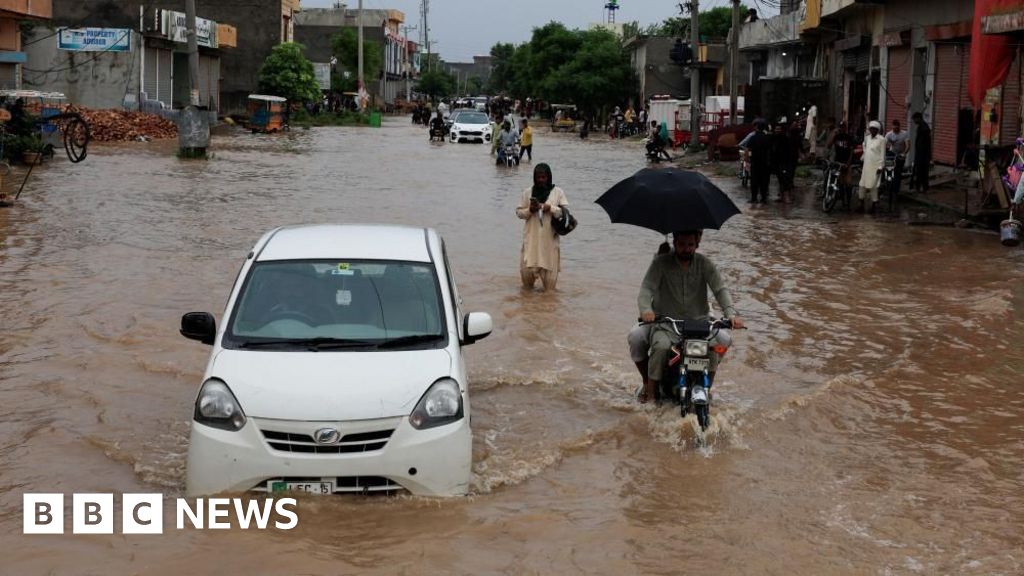Some 200,000 people have been evacuated as floods devastate parts of Pakistan's Punjab province. Rescuers carried residents to safety in boats after disaster authorities warned of exceptionally high floods along the Ravi, Sutlej and Chenab rivers. Several districts called in the army to help.
It comes after Pakistani officials said India had warned it would release water from major dams upstream, causing heavy flooding in parts of what is Pakistan's most populous province.
Both countries have suffered intense rainfall in recent weeks, with monsoon rains killing more than 800 people in Pakistan since June.
The country's National Disaster Management Authority (NDMA) has warned people in affected areas to stay away from rivers, drains and low-lying zones. Prime Minister Shehbaz Sharif said the federal government would fully co-operate with regional authorities to avert the risk of flooding, particularly in the urban areas of Gujarat, Sialkot, and Lahore – Pakistan's second-most populous city. Sialkot has seen more rainfall in 24 hours than the highest record in the past 49 years, according to Pakistan's chief meteorologists. This has left cars, homes and buildings submerged.
Many of the city's residents are stranded, the federal planning minister has told the BBC. Rescuers have been going door-to-door in villages, relocating residents and their livestock by boat. These boats have saved more than 32,000 people who were trapped by floodwater, local officials report. The Sutlej River had overflowed, submerging homes and washing away the walls meant to protect them.
One resident, Nadeem Ahmad, told us he was refusing to leave. He has been through multiple evacuations over the years and said his family simply can't afford to leave once again. He showed us the dozens of cows he keeps near his home, and the hay he stores to feed them. I'm already using their winter supply, he said. Others have accepted help from emergency teams, choosing to stay in shelters or with friends and relatives who live on higher ground.
These floods are ruinous to many families in a country where more than 40% of people live below the poverty line. Many people have expressed their reluctance to evacuate, preferring to protect their possessions instead, even at great risk.
According to disaster authorities in Pakistan, Wednesday's flooding follows a warning from India that it would release water from major upstream dams. When India's reservoirs overflow, the consequent water release can trigger severe flooding downstream across swathes of Pakistan's Punjab. India’s warning marks a rare instance of public communication between the two countries, which recently experienced military conflict. Both nations have faced extreme monsoon conditions, leading to significant loss of life and property.
It comes after Pakistani officials said India had warned it would release water from major dams upstream, causing heavy flooding in parts of what is Pakistan's most populous province.
Both countries have suffered intense rainfall in recent weeks, with monsoon rains killing more than 800 people in Pakistan since June.
The country's National Disaster Management Authority (NDMA) has warned people in affected areas to stay away from rivers, drains and low-lying zones. Prime Minister Shehbaz Sharif said the federal government would fully co-operate with regional authorities to avert the risk of flooding, particularly in the urban areas of Gujarat, Sialkot, and Lahore – Pakistan's second-most populous city. Sialkot has seen more rainfall in 24 hours than the highest record in the past 49 years, according to Pakistan's chief meteorologists. This has left cars, homes and buildings submerged.
Many of the city's residents are stranded, the federal planning minister has told the BBC. Rescuers have been going door-to-door in villages, relocating residents and their livestock by boat. These boats have saved more than 32,000 people who were trapped by floodwater, local officials report. The Sutlej River had overflowed, submerging homes and washing away the walls meant to protect them.
One resident, Nadeem Ahmad, told us he was refusing to leave. He has been through multiple evacuations over the years and said his family simply can't afford to leave once again. He showed us the dozens of cows he keeps near his home, and the hay he stores to feed them. I'm already using their winter supply, he said. Others have accepted help from emergency teams, choosing to stay in shelters or with friends and relatives who live on higher ground.
These floods are ruinous to many families in a country where more than 40% of people live below the poverty line. Many people have expressed their reluctance to evacuate, preferring to protect their possessions instead, even at great risk.
According to disaster authorities in Pakistan, Wednesday's flooding follows a warning from India that it would release water from major upstream dams. When India's reservoirs overflow, the consequent water release can trigger severe flooding downstream across swathes of Pakistan's Punjab. India’s warning marks a rare instance of public communication between the two countries, which recently experienced military conflict. Both nations have faced extreme monsoon conditions, leading to significant loss of life and property.



















